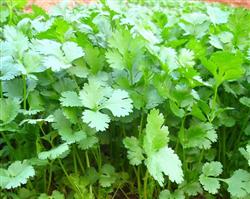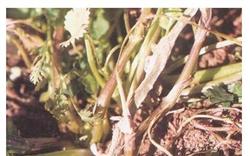Three key points for delayed harvest of coriander

When the market for coriander is bad, farmers often postpone the harvest in order to sell it at a high price. Although this practice is good, we should pay attention to strengthen management, otherwise the decline in quality is difficult to sell, and the loss outweighs the gain. The height of parsley suitable for sale is 20cm to 30cm. Therefore, the delayed harvest of coriander must control its growth potential, so that its height does not exceed 30 cm. In addition to controlling water and fertilizer, the more effective measure is to spray 1500 times of zhuangsu or 3000 times of Aizuo on the leaf. Sunshade coriander is most afraid of high temperature, too high temperature is not conducive to the growth of parsley, and it is easy to die. Therefore, for the delayed harvest of coriander, a sunshade net should be set up to cool down, so as to avoid the phenomenon of poor growth and dead trees in the high temperature at noon. Cilantro with anti-rotten leaves near harvest is prone to bacterial diseases and rotten leaves because the stems and leaves are larger and denser and the plants are more gloomy in the environment of high temperature and humidity. Therefore, during the delayed harvest of coriander, we must strengthen prevention and strictly prevent rotten leaves.
- Prev

Key points of coriander cultivation techniques
As a seasoning vegetable, coriander is rich in nutrition and simple in cultivation and management. the key points of coriander cultivation techniques are introduced as follows: the characteristics of parsley belong to Umbelliferae. It can withstand the low temperature of-1 ℃ to 2 ℃, and the suitable growth temperature is from 17 ℃ to 20 ℃. It grows slowly when it exceeds 20 ℃, and stops growing when it is 30 ℃. Coriander to soil.
- Next

Field management method of coriander
Sclerotinia sclerotiorum caused by Sclerotinia sclerotiorum has become a major obstacle in the production of parsley with the continuous expansion of coriander planting area in recent years, especially the difficulty of crop rotation in protected areas. First, symptom identification Sclerotinia sclerotiorum is mainly harmful to the base of the stem, followed by leaves. At the beginning, out.
Related
- Where is it suitable to grow horseradish in China? it is expected to see the middle altitude horseradish in Alishan.
- How to prevent tomato virus disease reasonably? (Control methods included)
- Many people like to plant towel gourd on the balcony. What are the main points of this method and management?
- What crops can chili peppers be mixed with?
- Fertilization techniques and matters needing attention in Tomato
- What are the grafting techniques for peach seedlings in spring?
- Harm and control methods of root swelling disease of Chinese cabbage
- What are the pests of sweet potatoes? How to prevent and cure it?
- Symptoms, causes and Control methods of navel Rot in Tomato
- The cause of "Cucumber rotten bibcock" in Farmers' planting Cucumber and its Control Plan

